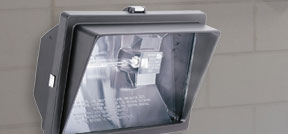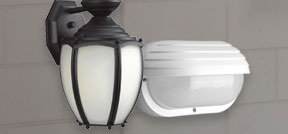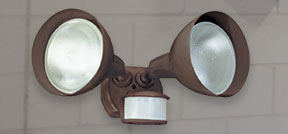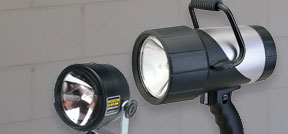Outdoor lighting
Outdoor lighting
has shined a light across many different vocational fields. Trades as varied as retail and marketing rely on outdoor light fixtures, as they illuminate stores and office buildings. Facilities and plants rely on outdoor lighting for added security, while consumers request everything from landscape lights to decorative fixtures to complete their exterior design.
Regardless of the industry or use, outdoor lighting is a great complement to buildings, enhancing its look and adding security during nighttime. While it’s clear that outdoor lighting is a necessity, uncovering your specific lighting needs may require more information. Browse our outdoor lighting guide, and discover the different types of outdoor lights, their best applications and tips for easy installation.
Types of Outdoor Lighting
Flood Lights

Flood lights provide wide-spanning lighting, covering large areas and hidden nooks that may not be easy to illuminate. These lights can help protect individuals and property from robbery, as well as buildings and other public spaces from vandalism. Flood lights are common in large spaces, including stadiums and parking lots, and utilize LED for superior spotlighting.
Things to Consider:
Before installation, decide which type of flood light is right for you by considering the level of brightness you need. Large areas should be powered with a high-pressure sodium or halide security light.
How to Install Flood Lights:
- Find a (high) point of installation and locate a power source, which can be indoors such as an inside outlet.
- Cut a hole in your building’s location to fit the light and the electrical cable through it.
- Connect it to a power source, and run a few test lights.
Landscape Lights

Landscape lighting is a wide-encompassing type of outdoor lighting, as it is used for both private and public spaces. Parks, office building terraces and public verandas depend on landscape lighting —such as globes, spotlights and LED light fixtures—for security and public enjoyment. Landscape lighting includes core elements of organic design, LED use, light pollution, scale and controls.
Things to Consider:
Landscape lights such as lanterns and sconces are used to highlight floral and greenery, as well as outdoor industrial spaces, emphasizing architectural features like columns. Like flood lights, landscape lights bring utility to outdoor spaces at night and can aid in crime prevention.
How to Install Landscape Lights:
- Line a pathway using the light fixtures on the ground 8-10 feet apart. Use a shovel to separate grass from soil and fold over the scalped portion of sod and create a 3-inch trench.
- Insert the low-voltage electrical cable into the trench, and bury it no more than 3-inches deep.
- Connect the cable to an outdoor electrical outlet, prepare holes for the fixture’s stake with a large screwdriver, make the electrical connections and insert the light fixture into its metal ground stake. Test the lights to ensure a steady connection.
Motion Sensor Lighting

How do motion sensor lights work?
Motion sensor lighting is the use of lighting installed with motion sensors. Sensors consist of small electronic pieces that detect infrared waves, that radiate when things move. When a motion sensor detects a considerable amount of heat radiation, which is present in people, animals and cars, it turns the lights on automatically. An administrator can preset the timer for the lights to stay on roughly within a 1-20 minute range. This function only works at night and during dark hours, as it is deactivated during the day via a photocell.
Things to Consider:
Motion sensors are installed in many facilities and their driveways, garages and alleyways. They can be calibrated not to turn on during unnecessary circumstances, such as in the blowing of leaves or a nearby car. This is done via the distance range setting and limiting the sensor’s field of view by way of aiming in the installment process.
- Adjust the field-of-view angle to set the distance range of the motion detector to prevent unsought lighting.
- Keep the bulb and detector at a solid distance to prevent fooling the detector and to prevent moisture.
- Buy a bulb with bulb seals, and position them facing down so water doesn’t access the socket.
Spotlights

Typically used in accent lighting and landscaping, spotlights offer direct and focused light on key areas. Illuminate signage, doors, fixtures and details with spotlights. Spotlights differ from flood lights in that instead of spreading light across a wide area, spotlights focus beams in narrow lines directed at one focal point.
Things to Consider:
Don’t overdo it with spotlights. The idea is not to highlight too many points otherwise your building will be over-lit, potentially drawing more attention. Key areas to highlight include signs, trees, statues, architectural features, pools and waterways.
How to Install Landscape Lights:
- Locate the GFCI outlet, and place the power pack nearby.
- Select the area for your spotlight, and determine the trench line before digging (if a cable is required).
- Assemble the spotlight according to manufacturer’s specifications.
- Dig a hole for the stake, and drive light in.
- Connect spotlight to power source.
- Connect power pack to outlet.
Choosing the Right Type of Outdoor Lighting
When it comes to selecting the right type of outdoor lighting fixtures, utility and need should be important decision factors. Fixtures for security differ from those for large areas or decorative landscape lighting. Check out this chart to determine the best type of outdoor lighting and outdoor fixture for your needs.
| Need | Type of Lighting | Best Fixtures |
|---|---|---|
| Security | Motion Sensors Flood Lights |
Spotlights Bullets |
| Accent Lighting | Landscape Lighting Spotlights |
Pathway Lights Globes Wall Sconces Bullets |
| Large Areas | Flood Lights | Induction Floodlights Halogen Floodlights |
| Focused Areas | Spotlights | Bullets |
Powering Outdoor Lights
Powering outdoor lights depends on your building’s power source as well as how frequent your outdoor lighting will be in use. There are three key ways to power your lights: low voltage, line voltage and solar powered.
- Low Voltage: This lighting operates at 12 volts, making it energy efficient and easy to install.
- Line Voltage: This lighting operates at 120 volts and for outdoor lighting requires electrical conduits to protect wires and junction boxes. This is best for floodlights and high-powered lighting.
- Solar Powered: Requires no wiring, but fixtures should be installed where they will get lots of lights. Solar-powered lights are fairly easy to install and great for outdoor areas where electrical power is not easily accessible.
A Final Word on Outdoor Lighting
Outdoor lighting can be a necessity for a variety of outdoor spaces and buildings. While some types provide aesthetic enhancements, outdoor lighting as a whole is a solid precautionary method to keep intrusions, vandalism and other crime at a minimum, as well as provide a safer and more visible space during dark hours.
Comment (1)
Leave a Comment









A WordPress Commenter
January 27, 2021Hi, this is a comment.
To get started with moderating, editing, and deleting comments, please visit the Comments screen in the dashboard.
Commenter avatars come from Gravatar.